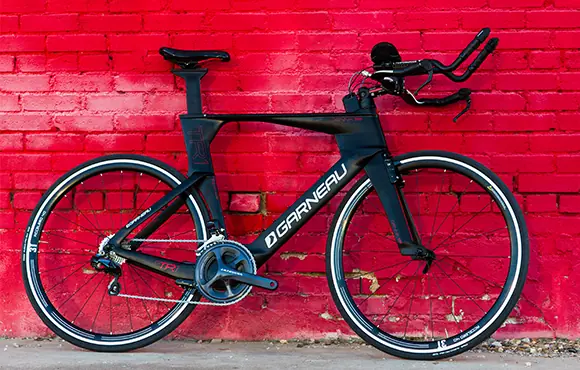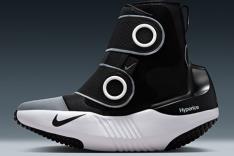Aesthetics / Frame
1 of 12
At first glance, the Gennix TR1 looks sharp. Not sharp because of its tuxedo-black paint scheme, but sharp because of the hard edges consistent throughout the build of the bike. The frame is shaped with RTCC2 carbon that is both stiff and dampens road vibrations. Power transfer is not an issue here--the thick chain and seat stays coupled with the aerodynamic tubing and proper tri geometry make for a responsive ride and a great climbing bike, perfect for hilly courses. It's aero, stiff and handles superbly. Everything you should expect from a high-end frame.
Rear End
2 of 12
The Gennix TR1 Elite includes a Shimano Di2 Ultegra 6870 rear derailleur and, while not as light as its Dura-Ace counterpart, we found the shifting to be ultra-reliable, even when under load. We were impressed by the battery life, too--we only had to charge it after every five to six rides, and mostly just because we were nervous. Garneau cut costs by including a Shimano 105 cassette and, again, while not as light or crisp as an Ultegra or Dura-Ace option, you can always upgrade down the road.
The bike features a vertical rear dropout, which ultimately makes removing the wheel easier, but doesn't allow the wheel to be moved closer to the frame (aero penalty).
Crank / Front Derailleur
3 of 12
Companies generally reduce costs by including cheaper saddles, cassettes (as mentioned) and cranks, so we were pleased to see Garneau included an Ultegra crank (FC-6800 series, compact 52/36T) to the build. The front derailleur is Shimano Di2 Ultegra 6870 as well, and we had no issues with its performance. Reliable shifting and a stiff crankset is often taken for granted, but never gets old.
Seat Post / Saddle
4 of 12
The seat post is Garneau's carbon aero offering, and has considerable height and fore/aft adjustability (120mm). The system utilizes the super popular Ritchey one-bolt design saddle clamp, known for how easy it is to adjust.
Like most bikes at this price point, we found ourselves swapping out the more traditional Garneau 0.005 MACH saddle (minimal relief channel, long nose) for a more comfortable option. The 0.005 MACH worked well enough for shorter distances, but wasn't appropriate for 140.6 efforts.
Bottle Mount / Truncated Airfoil Design
5 of 12
Garneau has included three bolts on the downtube, which allows the athlete to choose a lower or higher bottle position. Our aero bottle wouldn't fit in the lower offering, but a classic bottle fit without issue.
The RTCC2 carbon frame was designed with a truncated airfoil, meaning the trailing edge is removed to increase aerodynamics at high yaw angles. It's hard to get quantitative here, but qualitatively the bike felt like it sliced through the wind extremely efficiently and felt solid and stable in shifting wind patterns.
Stem / Di2 Junction
6 of 12
Unlike the rest of the tri industry, Garneau went with a regular, non-integrated 31.8mm stem and alloy (less expensive) 3T aerobars. While this has a large aero penalty, it makes adjustments more convenient and aftermarket parts easier to swap out. We found the aerobar extensions were slightly uncomfortable due to an awkward outward set wrist position.
The Di2 junction box is stored in a container set behind the stem. In order to charge the battery, the cap must be unscrewed and removed to gain access to the charging port. There is an additional aero penalty for all the uncontained cables and wires behind the cockpit as well.
A true tri frame, Bento box mounts are included on the top tube.
Editor's Note: The newest edition of the Gennix TR1 Elite Di2 includes a non-integrated 3T Violia Team carbon cockpit.
Brake Levers / Di2 Shifters
7 of 12
Basebar brake levers are never the most sturdy, but these Shimano Di2 Ultegra 6871 TT levers felt solid, even when braking hard. If you prefer a different style lever, they are compatible with other TRP, Magura and TriRig options. Unlike its mechanical counterparts, Di2 shifting is available from both the aerobar extensions and the basebar.
Di2 Shifters
8 of 12
Again, shifters are mounted on both the aerobar extensions and the basebar grips. This is a reliable and convenient feature, especially on long distance rides when you're sitting up for a portion of the time. No issues here.
Brakes
9 of 12
The integrated brakes are made for Garneau by TRP, designed specifically for the TR1 fork. We found they didn't have the stopping power of traditional dual pivot brakes, but were considerably more aerodynamic. The Di2 battery is stored inside the frame and is accessed under the bottom bracket.
Wheelset and Fork
10 of 12
The front end includes an FSA Orbit integrated headset, internal cable routing and a full carbon ABS TRI fork (UCI legal fork also available). Deemed "Aero Balance Steering," Garneau has moved the pressure center of the wheel closer to the bike for a purported 24 percent increase in stability. We felt the ride handled more tightly, and the front end felt considerably more stable when running deeper wheels.
The Gennix TR1 Elite comes stock with a 3T Accelero 40 alloy wheelset. While a durable and slightly aero training wheelset, we will be turning to a deeper carbon wheelset for race day.
Overall
11 of 12
For Garneau's first North American offering, the Gennix TR1 Elite Di2 is a solid triathlon bike. It's obvious that rider experience was in the forefront of the designer's mind--not only is the bike aero, but it's stiff, handles flawlessly and climbs better than most tri bikes we've tried.
With a highly customizable fit, a pleasant efficiency-to-comfort ratio and an accessible price tag, the Gennix TR1 Elite Di2 is the perfect next step for a triathlete looking for an upgrade. A standard mechanical Ultegra option also is available for $4,000.
$5,500, louisgarneau.com.






Discuss This Article